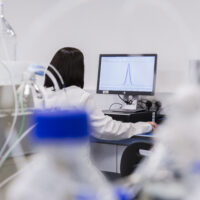Analytical method development for synthetic peptide for purity and impurities content by UHPLC
Peptide-related impurities found in synthetic peptides may be process-related or peptide-degradation products. The potential number of individual impurities observed in a crude peptide could theoretically be in the millions. However, most of these impurities should be removable during the purification step. The purity of synthetic peptides is usually measured by reversed phase ultra-high-performance chromatography (RPUHPLC) with ultraviolet (UV) detection in combination with mass spectrometry (MS).
This case study, authored by Ruth Bell, Senior Analytical Team Leader, Almac Sciences, and Jerome Pretre, Analytical Technical Leader, Almac Sciences, is presented to illustrate the different challenges encountered during peptide analytical method development and to outline Almac’s approach to develop a suitable stability indicating UHPLC purity method. With experience of the development and validation of complex analytical methods for a wide range of peptides over the last 10 years, Almac Sciences has developed a strategy to efficiently develop purity methods.
Published Pharmaceutical Technology 2023.
View Resource

